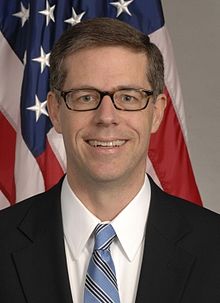
#IgniteAPDU at the Annual APDU Conference
Keynote Speech
The #IgniteAPDU Keynote was delivered by Mark Doms, the Undersecretary for Economic Affairs at the Economic and Statistics Administration. His address was a frank and enlightening discussion stressing the importance of data-sharing between agencies and public-private partnerships. Mr. Doms also laid out his vision for smarter, faster, and more accurate data in the immediate future.
Coordination between data providers and data users is one of the key strategies to make data more visible while also increasing its accuracy and timeliness. Mr. Doms discussed the extensive work being done to make the 2020 census smarter. By encouraging coordination between the Census Bureau and other agencies the government hopes to use data to increase response rates. Coordination will also make it easier for users to find, match, and merge data.
Public-private partnerships are also essential to increasing the availability and accuracy of public data. By partnering with large corporate entities and utilizing private sector data the government is working towards providing real time information to users. This would allow public, private, and non-profit data users to innovate at a much faster and efficient rate.
Attendees asked a number of incisive questions at the end of the speech which allowed Mr. Doms to flesh out some of his points. Several questions focused on the need to protect public data from budget cuts. Mr. Doms laid out the various ways users can emphasize to Congress the need for public data programs. Private entities can testify about the different ways they utilize public data to improve their productivity and build their infrastructure. Public users can show elected officials the various ways public data can be used to benefit their constituents.
#IgniteAPDU Talks
Innovation was one of the buzzwords at the APDU conference. This was exemplified by a new panel format which focused on hot trends and topics in the world of public data. The #IgniteAPDU Talks featured six speakers from a wide range of public, private, and non-profit data organizations. The panel, moderated by Kathy Pettit, offered attendees a quick, five-minute look at the tools and techniques these organizations are using to connect with their users and to provide accurate, easy-to-use, and visually appealing data.
Public data providers must adapt to a world with increasingly varied modes and forms of communication. Several trends became apparent across the public data universe, including the ability to use social media, ease of use for data users, taking advantage of new technology to ensure accuracy, and visual appeal of data.
- Doug Marcey of Phase2 concentrated on the use of narratives to explore data. He also discussed the ability to share data and use this to drive traffic to websites.
- Carlos Manjarrez of the Institute of Museum and Library Services also discussed the need leverage social media data while building new, open, and innovative data resources.
- Melissa Maynard of Pew Charitable Trusts stressed the ease of use of Tableau. Giving users the ability to tweet and embed code directly from the program increases its accessibility.
- Sarah Happy of LawAtlas highlighted the need for flexibility to ensure accuracy and ease of use. By giving researchers the ability to decide what information is important they are able to keep their data up to date.
- Kim Becht of the U.S. International Trade Administration provided attendees with a breakdown of how her agency uses technology to scrape data from the web. This practice, along with tagging and crosswalking, ensures that their data is accurate.
- Carmen Jenkins of General Dynamics stressed the ability of visualization to bring data to life. Her presentation emphasized the various ways data producers can create visually appealing, web-traffic driving data output.
At the conclusion of the moderated panel, Nancy Potok, deputy director of the U.S. Census Bureau, was invited to speak about how the Census Bureau and the National Center on Health Statistics teamed up to measure health insurance coverage in a rapidly changing environment. Her presentation served to underscore the points made throughout #IgniteAPDU sessions. In a rapidly changing world data providers must coordinate and innovate, taking advantage of technological developments to ensure accuracy and relevance.